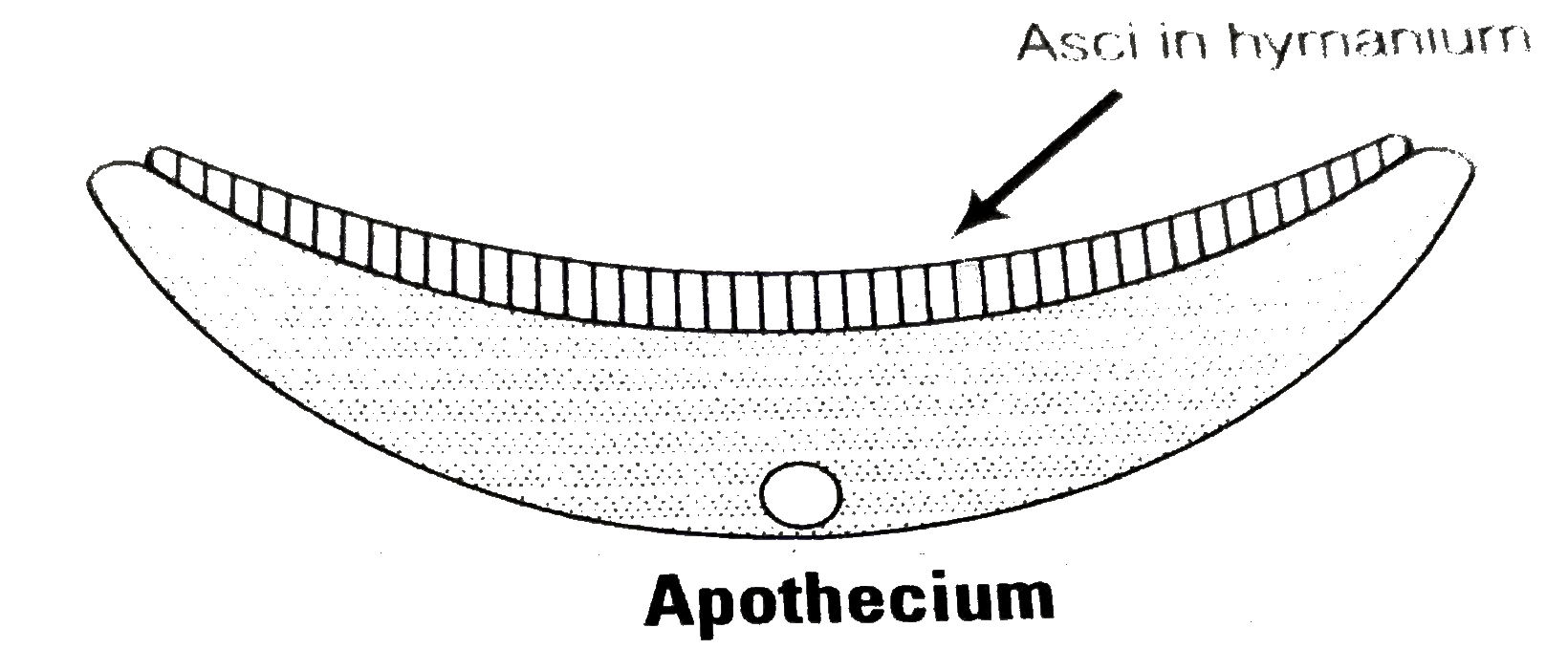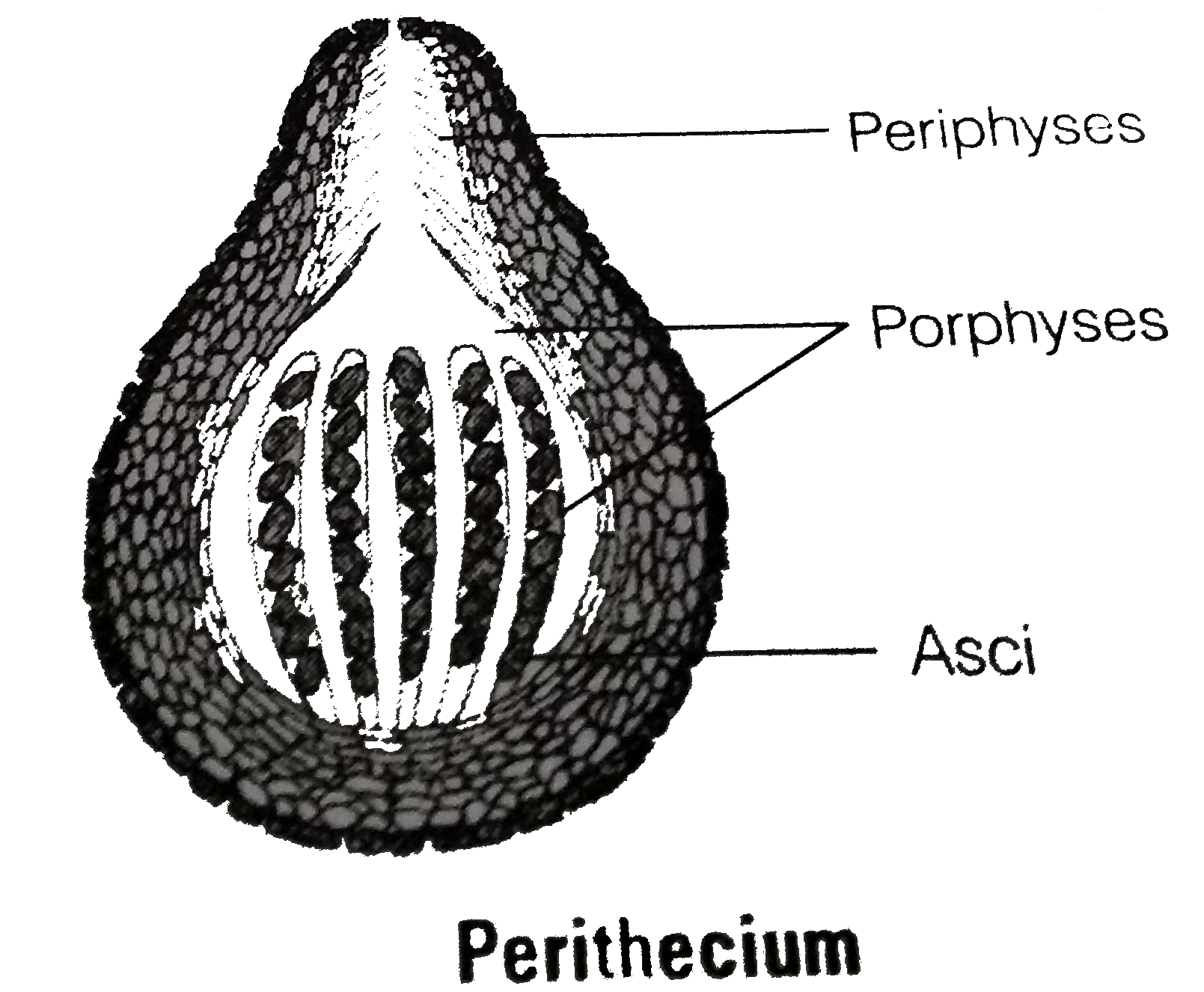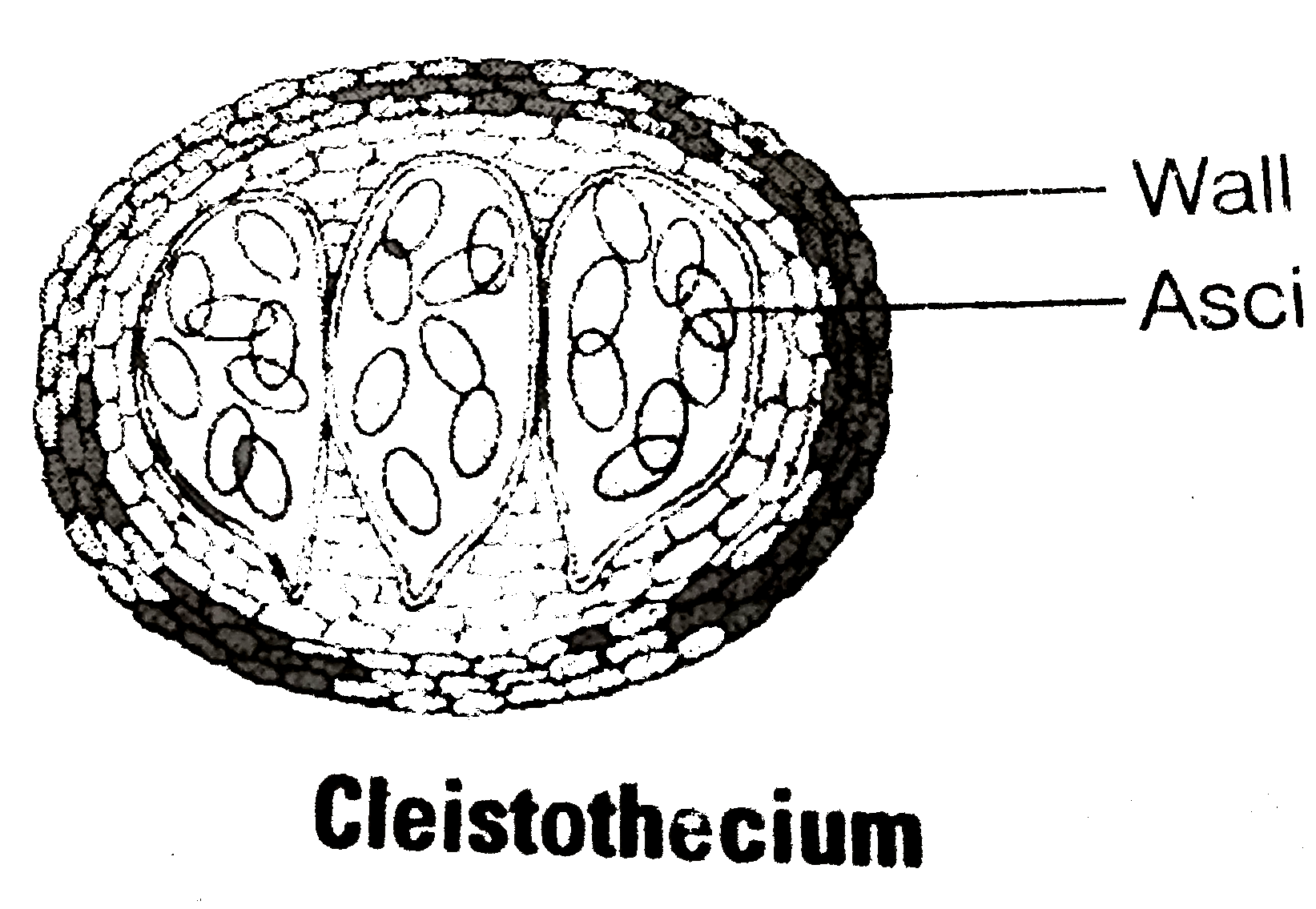At a stage of their cycle, ascomycetes fungi produce the fruiting bodies like apothecium, perithecium or cleistothecium. How are these three types of fruiting bodies different from each other ?
Discuss the type of fruiting bodies formed by ascomycets fungus and differentiate accordingly on the basic of there structures.
Ascomycetes Consists of sporangial sac called ascus. Asci (singular-ascus) may occur freely or get aggregated with dikaryotic mycelium to form the fruitification called ascocarps.
The fruitification formed by asci are like
(i) Apothecium is a cup like structure, e.g., Peziza

(ii) Perithecium flask shaped, e.g., Neurospora.

(iii) Cleistothecium closed with a slit, e.g, Penicillium

Topper's Solved these Questions
- BIOLOGICAL CLASSIFICATIONBook:NCERT EXEMPLAR ENGLISHChapter:BIOLOGICAL CLASSIFICATIONExercise:Long answer
Explore 5 Videos
- BIOLOGICAL CLASSIFICATIONBook:NCERT EXEMPLAR ENGLISHChapter:BIOLOGICAL CLASSIFICATIONExercise:Very short
Explore 8 Videos
- ANIMAL KINGDOMBook:NCERT EXEMPLAR ENGLISHChapter:ANIMAL KINGDOMExercise:LONG ANSWER TYPE QUESTIONS
Explore 4 Videos
- BIOMOLECULES Book:NCERT EXEMPLAR ENGLISHChapter:BIOMOLECULES Exercise:Long Answer Type Questions
Explore 5 Videos
Similar Questions
At a stage of their cycle, ascomycetes fungi produce the fruiting bodies bodies like apothecium, perithecium or cleistothecium. How are these three types of fruiting bodies different from each other ?
Discuss the type of fruiting bodies formed by ascomycets fungus and differentiate accordingly on the basic of there structures.
View SolutionCompare the different types of fruiting bodies in fungi.
View Solution
Knowledge Check
Four alternative summaries are given below each text. Choose the option that best captures the essence of the text.
The human race is spread all over the world, from the polar regions to the tropics. The people of whom it is made up eat different kinds of food, partly according to the climate in which they live, and partly according to the kind of food which their country produces. In hot climates, meat and fat are not much needed, but in the Arctic regions they seem to be very necessary for keeping up the heat of the body. Thus, in India, people live chiefly on different kinds of grains, eggs, milk, or sometimes fish and meat. In Europe, people eat more meat and less grain. In the regions, where no grains and fruits are produced, the Eskimo and other races live almost entirely on meat and fish.AFood eaten by people in different regions of world depends on the climate and produce of the region, and varies from meat and fish in the Arctic to predominantly grains in the tropics.BHot climates require people to eat grains while cold regions require people to eat meat and fish.CIn hot countries people eat mainly grains while in the Arctic, they eat meat and fish because they cannot grow grains.DWhile people in Arctic regions like meat and fish and those in hot regions like India prefer mainly grains, they have to change what they eat depending on the local climate and the local produce.Clouds are an essential part of the weather conditions which exist around us. Warm air rises upwards in the atmosphere carrying with it dust and moisture from evaporated surface water. At higher altitudes the air is cooler and the vapour in the warm air reaches its .dew point. where it changes either to small particles of ice or into water, thus forming clouds. Since cloud formation takes place at different heights and temperature, clouds are of different types.
There are basically three main types of clouds. Up to about 1-5km from the ground we generally see the first type called the .stratus. cloud, on occasions it is the grey stratus clouds which bear light rain. In colder areas the water in these clouds freezes, thus resulting in snowfall. Slowly rising warm air produces these clouds. Above these and up to about 4-5 km lie the .cumulus. clouds, the fluffy shapes are a result of quickly rising warm air. Above the cumulus clouds, at an altitude of about 14 km, float the .cirrus. types of clouds. Cirrus clouds are wispy clouds formed at such a high altitudes that they contain only ice crystals.
Laying between these three main types of clouds are other types like the .stratocumulus., .altocumulus., .cirrocumulus., .altostratus. and .cumulonimbus. clouds.
How are stratus clouds produced?ABy quickly rising cold airBBy slowly rising cold airCBy slowly rising warm airDBy quickly rising warm air
Both enzymes and hormones are produced by the glands present in our bodies. Find out how enzymes and hormones are different from each other
View SolutionHow are the sweat and sebaceous glands present in our body different from endocrine glands? What are such glands called? Name any one other gland of this type.
View SolutionA group of people in a locality of Delhi used to go for a walk in the morning . After the walk , they would often sit together and discuss the subjects like Politics , Demonetisation , Elections , Market prices of different goods , etc . There was about fifty persons in this group . One day , instead of other subjects, their focus of discussion was Market Prices of Different Goods . During the discussion , the emphasis laid on the point was that goods become very costly by the time they reach the consumers after getting transported from the producers . Consequently , everyone's budget is getting disturbed . To get rid of this problem some people suggested that they should join together to form a society . The society would sell the goods to all the members as per their requirements after buying them in a large quantity directly from the producers . This suggestion was appreciated by all of them . They all became members of the society and encouraged other people also to become its members . In no time , 100 members assembled and the society was formed . The idea of forming the society immediately proved to be successful. Now their budget became balanced . A special characteristic of this society was that apart from its members it also sold goods to the other people of the society at cheaper rates . All of them were very happy with the formation of the society .
(a) Identify and explain the type of the society formed by them .
(b) Under what Act , the society must have been formed ?
(c) What is the liability of the members of the society so formed ?
(d) Explain any one merit of the society so formed ?
View SolutionA group of people in a locality of Delhi used to go for a walk in the morning. After the walk, they would often sit together and discuss the subject like Politics, Demonetisation, Elections, Market prices of different goods, etc. There were about fifty persons in this group . One day, instead of other subjects, their focus of discussion was ' Market Prices of Different Goods. '. During the discussion, the emphasis laid on the point was that goods becomes very costly by the time they reach the consumers after getting transported from the producers . Consequentyl, everyone' budget is getting disturbed. To get rid of this problem some people suggested that they should join together to form a society. The society woudl sell the goods to all the members as per their requirement after buying them in a large quantity directly from the producers . This suggestion was appreciated by all of them. They all became members of the society and encouraged other people also to become its members. In no time , 100 members assembled and the society was formed . The idea of forming the society immediately proved to be successful . Now their budget became balanced. A special characteristics of this society was that apart from its members it also sold goods to the other peopole of the society at cheaper rates. All of them were very happy with the formation of the society.
(a) Identify and explain the types of the society formed by them.
(b) Under what Act, the society must have been formed ?
( c) What is the liability of the menbers of the society so formed ?
(d) Explain any one merit of the society so formed ?
View SolutionWhen a fertilised egg E formed in the oviduct of a human female divide repeatedly to from an embryo, the embryo gets implanted in the thick and soft lining of the uterus. After this a disc-like special tissue T develops between the uterus wall and embryo through which all the requirements of the developing embryo (and foetus) are net from the mother's body. The embryo is connected to the tissue T through a string like structure S.
(a) What is the other name of fertilised egg cell E?
(b) What in the name of tissue T?
(c) Name the string-like structure S
(d) Name two substances which pass from mother's blood to embryo through tissue T and, one type of substance which passes from embryo to mother's blood.
(e) What happens to S when the baby is born ? Why?
View SolutionName the basic nitrogeneous catabolite of proteins produced in birds. It what form is it eliminated from the body ? What is the advantage of this type of excretion.
View Solution
